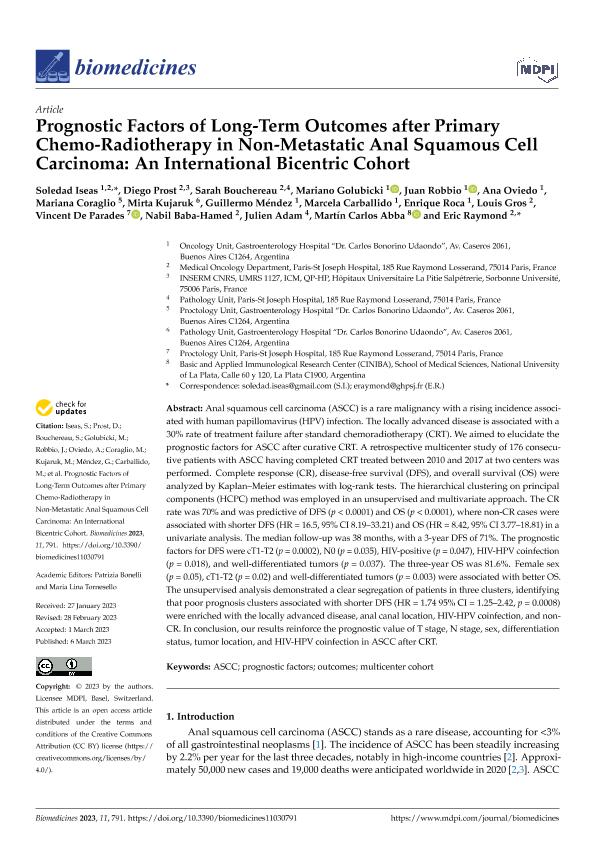Artículo
Prognostic Factors of Long-Term Outcomes after Primary Chemo-Radiotherapy in Non-Metastatic Anal Squamous Cell Carcinoma: An International Bicentric Cohort
Iseas, Soledad; Prost, Diego; Bouchereau, Sarah; Golubicki, Mariano; Robbio, Juan; Oviedo, Ana; Coraglio, Mariana; Kujaruk, Mirta; Méndez, Guillermo; Carballido, Marcela; Roca, Enrique; Gros, Louis; De Parades, Vincent; Baba Hamed, Nabil; Adam, Julien; Abba, Martín Carlos ; Raymond, Eric
; Raymond, Eric
 ; Raymond, Eric
; Raymond, Eric
Fecha de publicación:
03/2023
Editorial:
MDPI
Revista:
Biomedicines
ISSN:
2227-9059
Idioma:
Inglés
Tipo de recurso:
Artículo publicado
Clasificación temática:
Resumen
Anal squamous cell carcinoma (ASCC) is a rare malignancy with a rising incidence associated with human papillomavirus (HPV) infection. The locally advanced disease is associated with a 30% rate of treatment failure after standard chemoradiotherapy (CRT). We aimed to elucidate the prognostic factors for ASCC after curative CRT. A retrospective multicenter study of 176 consecutive patients with ASCC having completed CRT treated between 2010 and 2017 at two centers was performed. Complete response (CR), disease-free survival (DFS), and overall survival (OS) were analyzed by Kaplan–Meier estimates with log-rank tests. The hierarchical clustering on principal components (HCPC) method was employed in an unsupervised and multivariate approach. The CR rate was 70% and was predictive of DFS (p < 0.0001) and OS (p < 0.0001), where non-CR cases were associated with shorter DFS (HR = 16.5, 95% CI 8.19–33.21) and OS (HR = 8.42, 95% CI 3.77–18.81) in a univariate analysis. The median follow-up was 38 months, with a 3-year DFS of 71%. The prognostic factors for DFS were cT1-T2 (p = 0.0002), N0 (p = 0.035), HIV-positive (p = 0.047), HIV-HPV coinfection (p = 0.018), and well-differentiated tumors (p = 0.037). The three-year OS was 81.6%. Female sex (p = 0.05), cT1-T2 (p = 0.02) and well-differentiated tumors (p = 0.003) were associated with better OS. The unsupervised analysis demonstrated a clear segregation of patients in three clusters, identifying that poor prognosis clusters associated with shorter DFS (HR = 1.74 95% CI = 1.25–2.42, p = 0.0008) were enriched with the locally advanced disease, anal canal location, HIV-HPV coinfection, and non-CR. In conclusion, our results reinforce the prognostic value of T stage, N stage, sex, differentiation status, tumor location, and HIV-HPV coinfection in ASCC after CRT.
Palabras clave:
ASCC
,
MULTICENTER COHORT
,
OUTCOMES
,
PROGNOSTIC FACTORS
Archivos asociados
Licencia
Identificadores
Colecciones
Articulos(CCT - LA PLATA)
Articulos de CTRO.CIENTIFICO TECNOL.CONICET - LA PLATA
Articulos de CTRO.CIENTIFICO TECNOL.CONICET - LA PLATA
Citación
Iseas, Soledad; Prost, Diego; Bouchereau, Sarah; Golubicki, Mariano; Robbio, Juan; et al.; Prognostic Factors of Long-Term Outcomes after Primary Chemo-Radiotherapy in Non-Metastatic Anal Squamous Cell Carcinoma: An International Bicentric Cohort; MDPI; Biomedicines; 11; 3; 3-2023; 1-14
Compartir
Altmétricas



